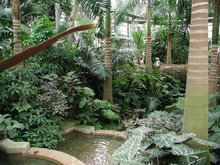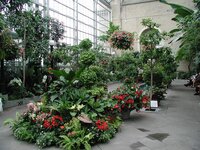Botanical garden
|
|

Botanical gardens (in Latin hortus botanicus) grow a wide variety of plants both for scientific purposes and for the enjoyment and education of visitors.
| Contents |
Research
The scientific work done at botanical gardens includes studies of how to adapt exotic plants to grow in the locale of the garden; taxonomic studies; and the propagation of rare or endangered species of plant. Kew Gardens, near London, has been publishing a scientific journal of botanical research, illustrated in color, since the late 18th century.
Educational work
Educational projects range from introductions to plants that thrive in different environments to practical advice for the home gardener. Many botanical gardens have plant shops, selling flowers, herbs, and vegetable seedlings suitable for transplantation. Some Botanical gardens such as the UBC Botanical Garden and Centre for Plant Research and the Chicago Botanical Garden have plant breeding programs and introduce new plants to the horticultural trade.
History
The first modern botanical gardens were founded in Northern Italy in connection with universities:
Other European towns followed suit:
- Leiden, Netherlands (1590)
- Montpellier, France (1593)
- Heidelberg, Germany (1597)
- Tübingen, Germany by Leonhart Fuchs
- Copenhagen, Denmark (1600)
- Uppsala, Sweden (1655)
- Hannover, Germany (1666)
See also
External links
- Brooklyn Botanic Garden (http://www.bbg.org/)
- Royal Botanic Gardens, Kew (http://www.rbgkew.org.uk/)
- New York Botanical Garden (http://www.nybg.org/)
- Royal Botanical Gardens, Burlington, Ontario (http://www.rbg.ca/)
- Royal Gardens of Herrenhausen, Hannover (http://www.hannover.de/herrenhausen/start.htm)
- Chicago Botanic Garden (http://www.chicago-botanic.org)
- Hortus Botanicus Leiden (http://www.hortus.leidenuniv.nl/english/)
- United States Botanic Garden (http://www.usbg.gov/)da:Botanisk have
de:Botanischer Garten he:גן בוטני lt:Botanikos sodas ja:植物園 pl:Ogród botaniczny pt:Jardim botânico ru:Ботанический сад sv:Botanisk trädgård

